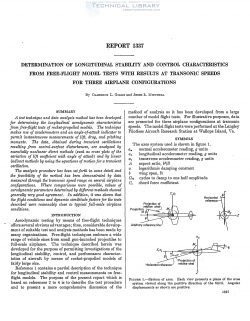naca-report-1337
- Version
- 157 Downloads
- 2.10 MB File Size
- 1 File Count
- November 2, 2016 Create Date
- November 2, 2016 Last Updated
National Advisory Committee for Aeronautics, Report - Determination of Longitudinal Stability and Control Characteristics from Free Flight Model Tests with Results at Transonic Speeds for Three Airplane Configurations

A test technique and data analysis method has been developed
for determining the longitudinal aerodynamic characteristics
from free-flight tests of rocket-propelled models. The technique
makes use of accelerometers and an angle-of-attack indicator to
permit instantaneous measurements of lift, drag, and pitching
moments. The data, obtained during transient oscillations
resulting from control-sun‘ace disturbances, are analyzed by
essentially nonlinear direct methods (such as cross plots of the
variation of lift coefficient with angle of attack) and by linear
indirect methods by using the equations of motion for a transient
oscillation.
The analysis procedure has been set forth in some detail and
the feasibility of the method has been demonstrated by data
measured through the transonic speed range on several airplane
configurations. Where comparisons were possible, values of
aerodynamic parameters determined by difi‘erent methods showed
generally very good agreement. In addition, it was shown that
the flight conditions and dynamic similitude factors for the tests
described were reasonably close to typical full~scale airplane
conditions.
Aerodynamic testing by means of free—flight techniques
offers several obvious advantages; thus, considerable develop-
ment of suitable test and analysis methods has been made by
many organizations. Free-flight techniques embrace a wide
range of vehicle sizes from small gun-launched projectiles to
full-scale airplanes. The technique described herein was
developed for the purpose of permitting investigations of the
longitudinal stability, control, and performance character-
istics of aircraft by means of rocket-propelled models of
fairly large size.
Reference 1 contains a partial description of the technique
for longitudinal stability and control measurements on free-
flight models. The purpose of the present report which is
based on references 2 to 4 is to describe the test procedure
and to present a more comprehensive discussion of the
method of analysis as it has been developed from a large
number of model flight tests. For illustrative purposes, data
are presented for three airplane configurations at transonic
speeds. The model flight tests were performed at the Langley
Pilotless Aircraft Research Station at Wallops Island, Va.
| File | Action |
|---|---|
| naca-report-1337 Determination of Longitudinal Stability and Control Characteristics from Free Flight Model Tests with Results at.pdf | Download |

Comment On This Post